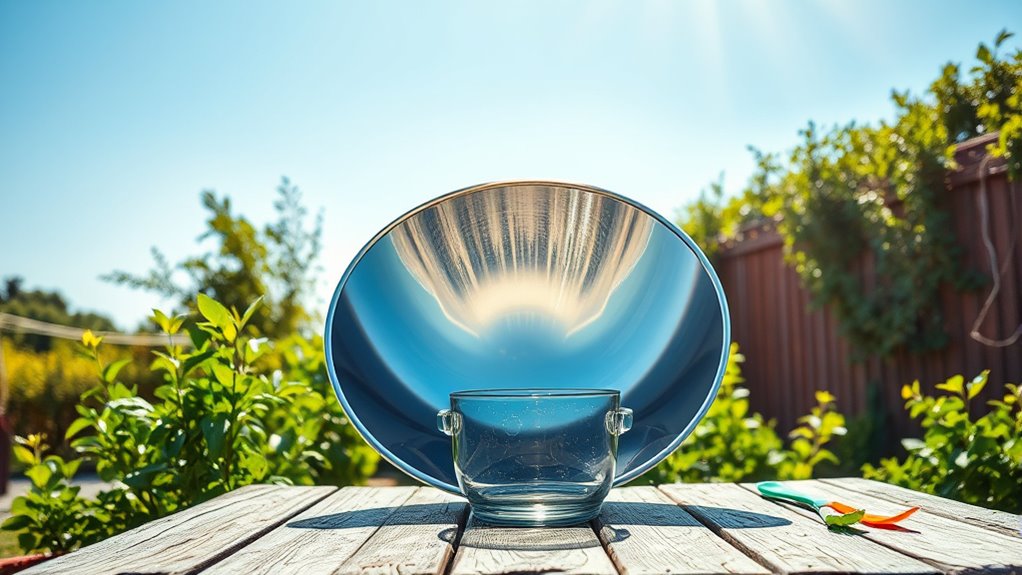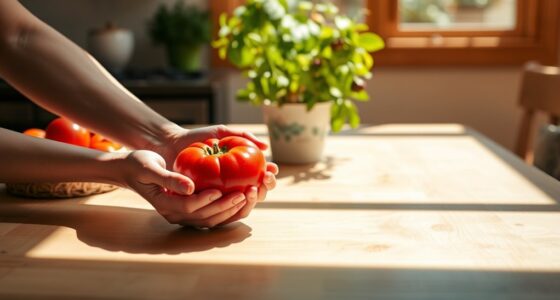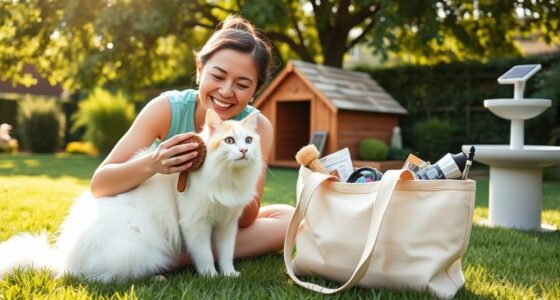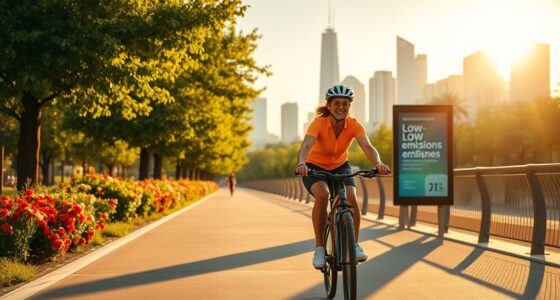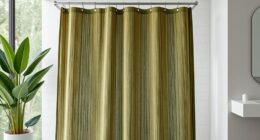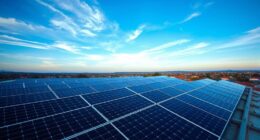Using a solar cooker lets you harness sunshine to cook food efficiently while saving money and reducing your carbon footprint. By focusing sunlight with reflective surfaces and adding insulation, you can prepare meals without relying on gas or electricity. DIY options are affordable, easy to customize, and perfect for sunny days. Want to discover simple tips to build and optimize your solar cooker? Keep exploring to uncover more eco-friendly cooking ideas.
Key Takeaways
- Solar cookers use sunlight to cook food, reducing energy costs and reliance on traditional fuels.
- Proper design with reflective surfaces and insulation maximizes heat absorption and retention.
- DIY solar cookers are affordable, customizable, and promote sustainable living practices.
- They are effective in sunny climates, reaching temperatures of 250°F to 300°F for efficient cooking.
- Using solar cookers lowers carbon footprints and offers an eco-friendly, cost-saving alternative for meal preparation.
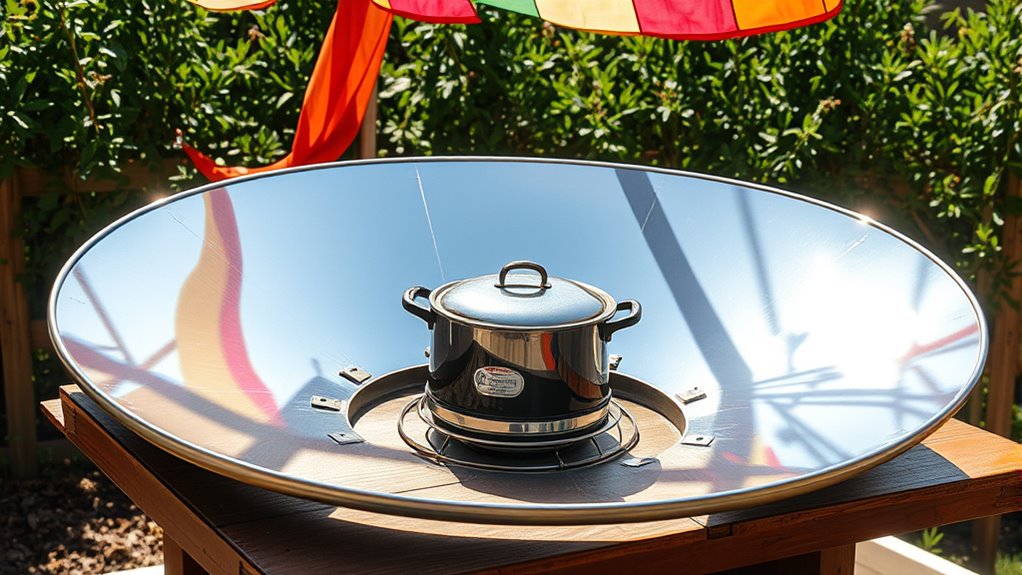
Have you ever considered how harnessing sunlight can simplify cooking? Solar cookers offer a sustainable, cost-effective way to prepare meals without relying on traditional fuels. One of the key factors to getting the most out of your solar cooker is understanding solar cooker efficiency. This refers to how well a solar cooker captures, retains, and converts sunlight into heat for cooking. The more efficient your solar cooker, the faster and more reliably it can prepare your food, even on partly cloudy days. Improving efficiency involves optimizing the design to maximize sunlight absorption and heat retention. For example, using reflective surfaces like aluminum foil or reflective panels can focus more sunlight onto the cooking area, boosting heat levels. Proper insulation also helps retain heat longer, making your solar cooker more effective and reducing cooking times. Additionally, paying attention to solar cooker efficiency can help you select or improve designs to better suit your local climate and needs.
If you’re interested in building your own, DIY solar cooker designs are plentiful and accessible. Creating your own solar cooker not only saves money but also allows you to customize it to suit your needs and local weather conditions. Simple designs, such as the box cooker, involve using a cardboard box lined with reflective material and lined with black paint or foil inside to absorb heat. These are easy to assemble, portable, and work well on sunny days. More advanced DIY options include parabolic solar cookers, which use a curved reflective surface to concentrate sunlight into a small, intense point of heat, allowing for quicker cooking times. These designs may require more materials and precision but can considerably enhance solar cooker efficiency.
When choosing or designing a DIY solar cooker, consider how much sunlight your location receives and the types of meals you typically prepare. A well-designed solar cooker can reach temperatures of 250°F to 300°F, enough to cook a variety of foods safely and efficiently. The key is to ensure your design maximizes sunlight exposure and minimizes heat loss. Using inexpensive, readily available materials like cardboard, aluminum foil, and black-painted surfaces makes it easy and affordable to experiment with different DIY designs. Plus, building your own solar cooker can be a fun, educational project that deepens your understanding of renewable energy and sustainable living. With patience and a bit of ingenuity, you’ll find that DIY solar cooker designs are not only practical but also empowering, allowing you to cook with sunshine while saving cash and reducing your carbon footprint.
Frequently Asked Questions
How Long Does It Take to Cook Meals With a Solar Cooker?
The solar cooking time varies depending on the meal and sunlight intensity. Typically, it takes about 1 to 3 hours to cook most dishes, making the meal preparation duration longer than conventional methods. You should plan ahead, especially on cloudy days, as solar cookers rely on direct sunlight. With patience, you’ll enjoy healthy, eco-friendly meals, and save money while reducing your carbon footprint during the solar cooking process.
Can Solar Cookers Be Used During Cloudy or Rainy Days?
Think of a solar cooker as a garden that thrives only in sunlight’s embrace. During cloudy or rainy days, cloud cover challenges your plans, making solar cooking tricky. While bright, sunny days are ideal, you can consider rainy day alternatives like traditional stoves or electric appliances. When the sky is gray, patience becomes your best tool, waiting for clear weather to return and let the sun’s energy shine on your culinary efforts.
Are Solar Cookers Safe for Children and Pets?
You might wonder if solar cookers are safe for children and pets. They are generally safe because they don’t use flames or electricity, reducing risks like burns or fires. However, always supervise children around the cooker to prevent accidental touching, and make sure pets are kept away during use to protect their curiosity. With proper child safety and pet protection measures, solar cookers can be a safe, eco-friendly cooking option.
What Types of Foods Are Best Suited for Solar Cooking?
Like Icarus reaching for the sun, you’ll find solar cooking best suited for certain foods. Fruit desserts and vegetable stews shine in this method, as they benefit from slow, gentle heat. You’ll enjoy the natural flavors preserved without added fats or oils. These foods adapt well to solar cookers, making your meals healthier and more eco-friendly, all while harnessing the sun’s energy to create delicious, nourishing dishes.
How Durable Are Solar Cookers in Extreme Weather Conditions?
You might wonder about the durability of solar cookers in extreme weather. Their material resilience varies, but high-quality models feature weatherproof design to withstand harsh conditions like heavy rain or strong winds. You should look for cookers made from sturdy, corrosion-resistant materials, and with sealed joints, ensuring they remain functional over time. Proper maintenance and choosing weatherproof designs will help your solar cooker endure even the toughest weather.
Conclusion
By choosing solar cookers, you save energy, save money, and save the environment. You embrace sunlight, harness its power, and enjoy delicious meals without pollution. You reduce costs, improve health, and make a difference—all while cooking with the sun. So, take action today, make a change tomorrow, and enjoy the benefits of solar cooking every day. Because when you cook with sunshine, you’re not just saving money—you’re saving the planet for future generations.
